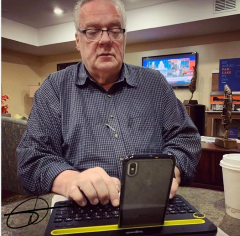This morning, I reviewed prior blog posts about taking the first steps toward a goal. I even listed those “first steps” that included solo flying and saying, “I Do.” I woke at about 4 a.m. thinking about taking that “next step” but not knowing what that step was or how I would know in which direction to go; what do you do now?
Unless there’s an emergency, you do not have to go fast.
Take your time.
If taking time is the right thing to do, plan your moves.
If planning is where you are, consider the ending as you plan the beginning.
Your first step should always be “thinking it through.”
While you are waiting on that future first step, what do you do in the meanwhile? Please wait…
I wondered about the First Man. Adam. When he breathed his first breath, and opened his eyes for the first time, what was the first thing he noticed? When he first stood, did he have balance, or was it one of those drunken-looking moves where Adam staggered and stumbled until he found his footing? What was the first sound that he made? Did he intuitively know a language, and if so, what was his first word? What was his first thought?
You can get dizzyingly tipsy thinking through this thought.
When a child starts to plan for that first day of school, is there any thought in supplies? Lunch? First-day clothes? Or wondering how he would get there? Teacher? When is recess? Do we get to take a nap?
When that child, soon to be an adult, sits behind the wheel of a car, what is the first thing they are taught to do? Seatbelts were starting to show up in the front seat in the early ’60s, so what was first then is not the same as first today.
I could stay on this for a long time! That’s how my mind works.
Move On, Move On Down the Road
I’m in the process of converting my blog into a series of books. Though I have an inkling of an idea, I’m spending time mapping out what chapters may look like and which blog posts would best fit where.
Of course, before I think of chapters, I must consider the theme. What did I say a few minutes before?
Take your time.
If taking time is the right thing to do, plan your moves.
If planning is where you are, consider the ending as you plan the beginning.
Consider the ending. That’s probably the best place to start. First steps from here to there, and knowing where the planned end helps me to itemize each stage and the needs along the way. Do you remember the old Triple A (known now as AAA) “TripTix?” You tell AAA where you are, your destination, how you are traveling, and the time frame you have in mind. They would map it out and create a paper map. You could flip from page to page to find out what to see along the way and good places to stop.
They did the hard work for you!
The internet and mobile technology have changed how we arrive at destinations. Someone, I know recently moved across the country, and they bought a Road Atlas to follow. Hmmm… My phone has ever-changing road conditions that a paper map can never show. I can talk to my virtual assistant (Siri, Alexa, etc.) on my phone and ask for additional information. My phone can tell you the weather and where others reported the speed traps just minutes ago! Can a paper map do that?
I used a familiar scripture recently.
Then the LORD answered me and said:
“Write the vision And make it plain on tablets, That he may run who reads it.
Habakkuk 2:2 NKJV
In essence? Set the vision. Write it, so it’s easily read for whoever, and wherever they come to the moment of reading from. It needs to be easily read and understood while on the run.
Take Your Time
I dislike rushing or getting somewhere in the “nick of time.” When going to a destination, I want to be there before starting. It gives me a framework for last-minute preparation or adjustment. It allows me to not stress should something happen along the way.
Generally, I always get to my destination with plenty of time to spare. Work. Church. Event. Only, I don’t want to take my last breath until I’ve stretched the living as far as it is possible to go!
How do I put that into practice? I know the general idea of traveling “there,” so I can determine when to leave “here.” Factor in some “fudge” time for possible bottleneck moments. Voila! I know when to go!
Rehearse the plan. Fine-tune the goal and steps. Now. Go when the timing is right.
Timing That First Step:Take your time. If taking time is the right thing to do, plan your moves. If planning is where you are, consider the ending as you plan the beginning. Share on X
